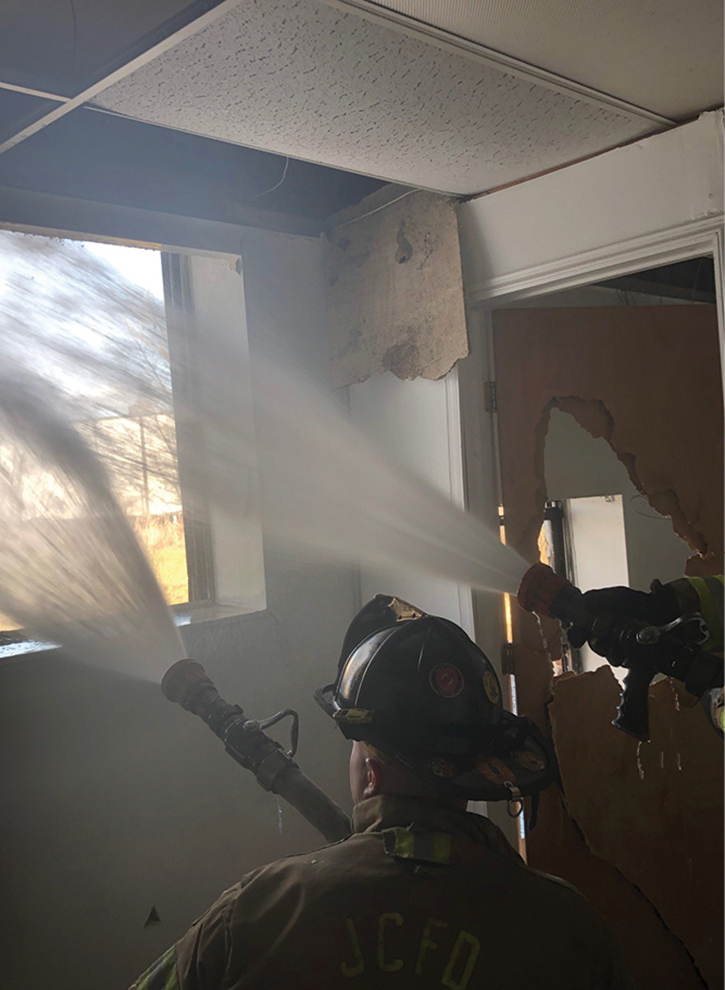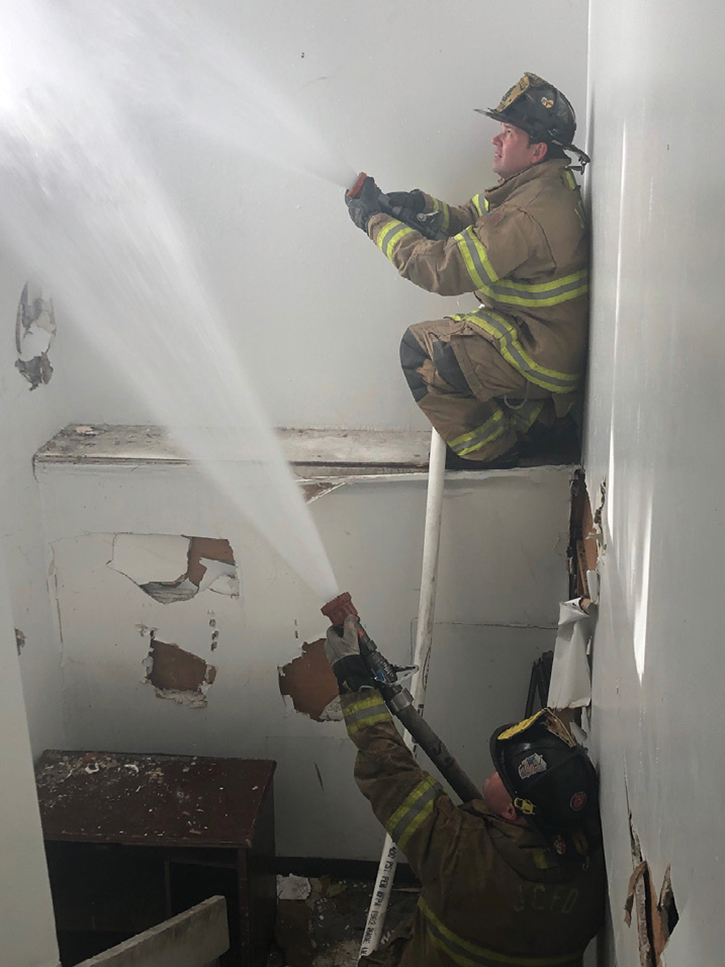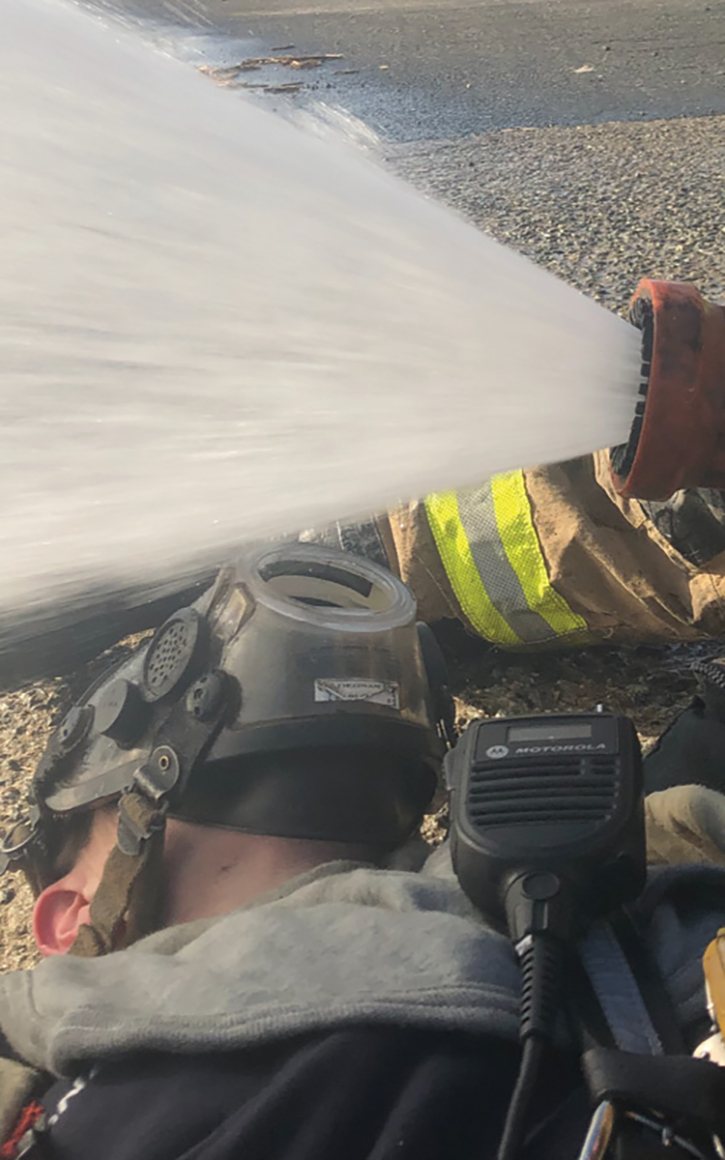
The Jersey City (NJ) Fire Department does a great deal of hydraulic venting. Venting out a compartmentalized room-and-contents fire is an automatic tactic post-knockdown. Getting to the nearest vent point, staying about six feet back, and opening a mid to narrow fog stream is a time-tested way to increase visibility; finish up an attack; accelerate post-control overhaul; and, most importantly, remove an unsustainable atmosphere from an area where potential victims can still be uncovered. To that point, I’d like to address some instances of proper and aggressive hydraulic ventilation at structural fires and why I consider it important.
Mark van der Feyst: Hydraulic Ventilation
Throw Back to Basics: Hydraulic Ventilation
Venting for Extinguishment at Peaked-Roof Dwellings
Note that you can achieve proper “fog venting” using the myriad of nozzles in a department’s arsenal, from a smooth bore gently cracked near the window opening to the 30° fog pattern from a fog nozzle. Our department uses both types. For a variety of reasons, I prefer the 15⁄16-inch smooth bore with a detachable fog tip for a 1¾-inch line and on a 2½-inch line, almost exclusively smooth bore.
Why It Works So Well
Without getting bogged down in the minutiae of the Venturi effect and Bernoulli’s equation, when a fluid flows into a narrower channel, its speed increases. We address this often with hoselines and nozzles. In this case, we think of the charged atmosphere that our team is venting as “fluid.” What hydraulic venting also does is create a pressure differential not only in the compartment but at the exit point. We know that, all other conditions being equal, convective currents (and the smoke and the heat contained therein) seek areas that are less pressurized than the area they are in. The current “wants” to achieve equilibrium with the rest of the compartment fire. We are also taught that this is why hotter smoke in a smaller compartment (such as a stud channel) rises and stratifies more quickly.
Hydraulically ventilating helps tremendously to achieve this equilibrium. It creates an area of lower pressure at the window by increasing the velocity of the smoke. The hot smoke “wants” to exit that window to a cooler and less pressurized area; the fog stream entrains and pulls smoke with it as it is discharged out the window. Since, by principle, we know the smoke will speed up as it pushes through an opening and that it does this because the pressure at the opening is lower than that in the surrounding area, using the water to give it a good push exponentially increases its “push” through the opening. The result is relief.
A point made in almost any study of hydraulic venting is worthy of noting again: By ventilating at the main source of the problem (the fire), the company has direct control of the by-products’ flow out of the opening, lessening the chance of flare-ups in other areas and contamination. It is true that hydraulic venting is not as effective as positive pressure in terms of volume of atmosphere moved. Hydraulic venting also keeps personnel in the path of combustion by-products and in the punishing atmosphere. However, with direct flow control and wearing good protective gear, it is a fair trade-off to quickly remove the atmosphere.
A good illustration to help us understand why this works so well comes from physics. Two cars that are next to each other on the highway are moving. As the driver of one of these vehicles, the sensation that you may be drifting toward the other is not an illusion. The reason for this is that the “speed” of the air in the small area between the cars is a lot faster than the air “around” the cars. This creates an area of lower pressure between the vehicles. In an attempt to equalize, the air around the cars makes a feeble attempt to “push” the cars together. How does this relate to the fire room? At an established exit point (e.g., a window), the speed of the current is faster as the hot smoke exits, just like the air between the cars. This creates a natural area of lower pressure at that exit point. So just as the cars are “pushed” toward each other, the atmosphere is pushed out the window. Now picture a hoseline hydraulically venting at that point, speeding it up/lowering the pressure at the exit, and you would multiply this effect. This simplified example lacks a full compartment, the heat, the smoke, and other variables, but it helps us to see why hydraulic venting works as well as it does: It builds on a natural effect of two differently pressurized atmospheres (photos 1-2).

(1) Photos by author.

(2)
Hydraulic Venting for Life
Among the important ways we can use hydraulic venting is during the primary search for life. Normally, it is almost taboo to vent through a window when you may draw fire and current to unsuspecting members and unconfirmed life hazards. You may spread the fire, interrupt the thermal balance, and cause many other problems associated with moving an environment around before you have controlled the fire. I refer in this instance to a confirmed life hazard and a confirmed location.
For example, consider a 2½-story wood-frame private dwelling with a looming smoke condition on the top floor. A fleeing occupant tells the first-arriving engine that a person is in the living room. Window size-up and prior knowledge may tell you that the living room is behind the three windows in a row on the second-floor Alpha side. Although I ardently believe that the best way to preserve a life is to put out the fire, removing the environment or the victim is a close second. Once the problem (fire) that is creating the unsustainable atmosphere is triaged, you need to get the atmosphere out of the compartment (hydraulic venting).
In the above case, consider a kitchen fire in the rear of the second floor. The line is duly placed between the living room and the fire, a knockdown is ordered, and the engine or first ladder crew conducts a quick primary search. For a down victim who is quite large in a tightly packed living room, you need to clear that smoke from the area immediately. If I were on the attack line at that fire and not in a position to immediately start hydraulic ventilation after knockdown, I would radio for the second line to proceed to the area of the down civilian and start hydraulic ventilation from there while I hold any flare-up in check. If the second line is backing me up as it should be, that company may be better situated to find a suitable location for hydraulic ventilation that would quickly remove the smoke from the victim’s location.
It is not always this cut-and-dried. Pushing the environment out at origin can be just as successful and is what happens at 99 percent of fires. It is nearly automatic. We can encounter problems and solutions at larger homes and apartments where the fire is tougher to unseat and we may have a confirmed life hazard.
Now, picture a large apartment with a confirmed life hazard and an engine crew with a tagline deployed through the bail of the charged line trying to find the seat of the fire. As they do, a ladder crew uncovers a victim who cannot be easily moved. Without diverting from the attack, make every effort to compartmentalize this area, create a refuge, and hydraulically ventilate the area with the first available hoseline.
Note the emphasis on the word “available.” In many departments, including mine, it is sometimes unfeasible to allocate a line to an area “just to vent” it. Resources are nearly always better spent taking care of the problem causing this area to need that ventilation—the fire. In this case, it may simply mean redirecting a backup line once the fire is in check. Closing off an area where a victim is before the fire is controlled is a cornerstone of sound search and rescue practice. “Isolate the area” is repeated time and again. To that, I might add: “Remove this atmosphere aggressively.” It is not enough to let today’s smoke vent naturally through openings. The point is to recognize and deal with this issue without taking away from the attack.
Communication between rescue crews and attackers is crucial. A transmission as simple as “Engine 20 from Ladder 10, once you have that knocked down, we could use some help getting the smoke out here” could pay big dividends. A civilian with unprotected lungs will be viable for far shorter a period than firefighters with self-contained breathing apparatus (SCBA), and pushing that environment out has to be at the forefront of our thoughts.
Tandem Hydraulic Ventilation
In today’s modern smoke conditions, aside from the increased toxicity, the sheer increase in the volume of smoke is sometimes staggering. Add to that the need to move smoke considerable distances to get to the vent point, and the choking atmosphere can seem to stagnate. Two prime candidates for what I call “tandem hydraulic venting” are basements and railroad apartments. Both have limited entry and exit points; both can wreak havoc on ventilation efforts.
Simply put, post-knockdown at a railroad apartment fire, if two lines are in place and window space is limited, you can operate one fog line into the other out of the opening to increase the velocity and thus lower the pressure at the opening. A good way to achieve this is to have one member crouch about six feet back from the window and operate a fog pattern accordingly. The other member stands behind the crouched member and operates the fog stream directly in line with the other. If the opening is large enough to permit members to operate side by side, that works as well.
In a basement fire with a rear entrance, a good practice post-knockdown would be to turn the line back the way you came and operate the fog pattern out of the doorway instead of out of the tiny basement window. Again, if two lines are around, operate one into the other (photo 3).

(3)
In a basement with only a first-floor/alley entrance, tandem hydraulic ventilation can work as follows: One member vents up the stairwell toward the alley door and a member on the first floor vents from the first-floor apartment downward toward the alley door, “catching” the smoke and pushing it through the doorway. Nowhere are the effects of good hydraulic ventilation more readily apparent than at a hot basement fire.
A word of caution: If venting post-knockdown, members need to stay lower than they normally would with hoods still in place and collars up. As the environment rushes past the back side of your neck and ears, you will feel it more than in a standard room and apartment fire. Limit your vulnerability to it (photo 4).

(4)
Hydraulic Ventilation on a Smaller Scale
In the worst of all instances, a down firefighter without air in the immediately dangerous to life or health (IDLH) atmosphere, hydraulic ventilation has its place on a much smaller level. Without going into all the efforts available to obtain fresh air for the down member (there are many), a narrow fog stream can be a great aid in obtaining any fresh air available through the mask opening. The technique is borrowed from an old way to obtain “fresh” air in a smoked-out room after knockdown: The member holds his face near a nozzle flowing on broken fog or fog stream, which draws in cleaner and cooler air and brief relief. Obviously, the sound move is to exit.
For this example, assume that the victim cannot yet be moved, Maydays and rapid intervention teams are in order and underway, and your primary concern at the victim’s location is that he is totally out of air and the atmosphere is still unfit although some air may be available. Yes, dragging to a more suitable place is in order; but “more suitable” may not be good enough. Operating a very tight fog pattern over (not into) the opening of the SCBA mask creates that pressure differential discussed earlier. It is on a smaller level because the line is being operated laterally over the mask opening; but yes, air flow will increase, be entrained over the opening, and be drawn into the mask opening (hopefully, over the mouth and into the lungs of the member in need).
If never experienced, it is a simple enough maneuver to practice under controlled conditions. Have a member lie down with his mask on without the regulator and another member operate a narrow fog close to and across the mask opening. Note, the exact placement of the fog stream will be predicated on the manufacturer and model of the mask, as the angle varies. The member “receiving” the air will tell you when the most air has been entrained. It is very important to remember that sound practices should always take precedence (photo 5).

(5)
Normally, removing a regulator in the IDLH environment is not warranted, especially if the heat and smoke condition is enough to sear lungs. In such a state, they need to be protected at the expense of air and the cost of possible internal damage. This would be for the situation in which a member is down; fire is generally abated or remote; and the primary hazard is suffocation, secondary is smoke inhalation.
Remember, this is not to advocate sending a line to a victim’s location with the expressed intent of performing this maneuver, nor is it a call to leave a member in an IDLH area in exchange for providing dirty air. This is a last-ditch call for supplying any type of feasible air to a down member who cannot be immediately moved. It would be an incredibly tough call to make, but staying to lower levels and drawing cooler air in will entrain some for the victim (photo 6).

(6)
A point made in almost any study of hydraulic venting is worthy of noting again: By ventilating at the main source of the problem (the fire), the company has direct control of the by-products’ flow out of the opening, thus lessening the chance of flare-ups in other areas and contamination. It is true that hydraulic ventilation is not as effective as positive pressure in terms of volume of atmosphere moved and that it keeps personnel in line with combustion by-products and in the punishing atmosphere. However, when you have direct control of the flow and are in adequate protective gear, it is a fair trade-off to start removing the atmosphere quickly.
It is vital to remember that because we are in the environment that is being vented, crews need to communicate with one another. A crew with a charged line moving to a location cannot simply decide to forcefully hydraulically ventilate a window for visibility’s sake. To do so could draw heat and fire, punish the attack, and hurt civilians. It is plainly bad practice. The primary hydraulic ventilation point remains at an origin subsequent to knockdown; only the immediacy of pushing the ever toxic environment out has changed.
Perhaps the simplest way to think of aggressive hydraulic ventilation efforts is to consider them as being analogous to putting our tools into play: the hose and nozzle. Just as water speeds up as it flows toward the narrowing tip of a smooth bore, so, too, does the punishing environment as it moves toward that vent point. In a compartment fire, we are “standing in the nozzle” of the fire environment and we increase its velocity out of the tip/window by hydraulically venting. Its importance is wholly commensurate with the increase in volume, heat, toxicity, obscurity, and the all-out hazardous nature of today’s smoke conditions. Put out the fire. Put the environment out the window.
ALEXANDER DEGNAN is a captain in Squad Co. 4 of the Jersey City (NJ) Fire Department, where he has served since 2005. Squad 4 is an engine company assigned to the 4th Battalion and responds to fire assignments as an engine.

